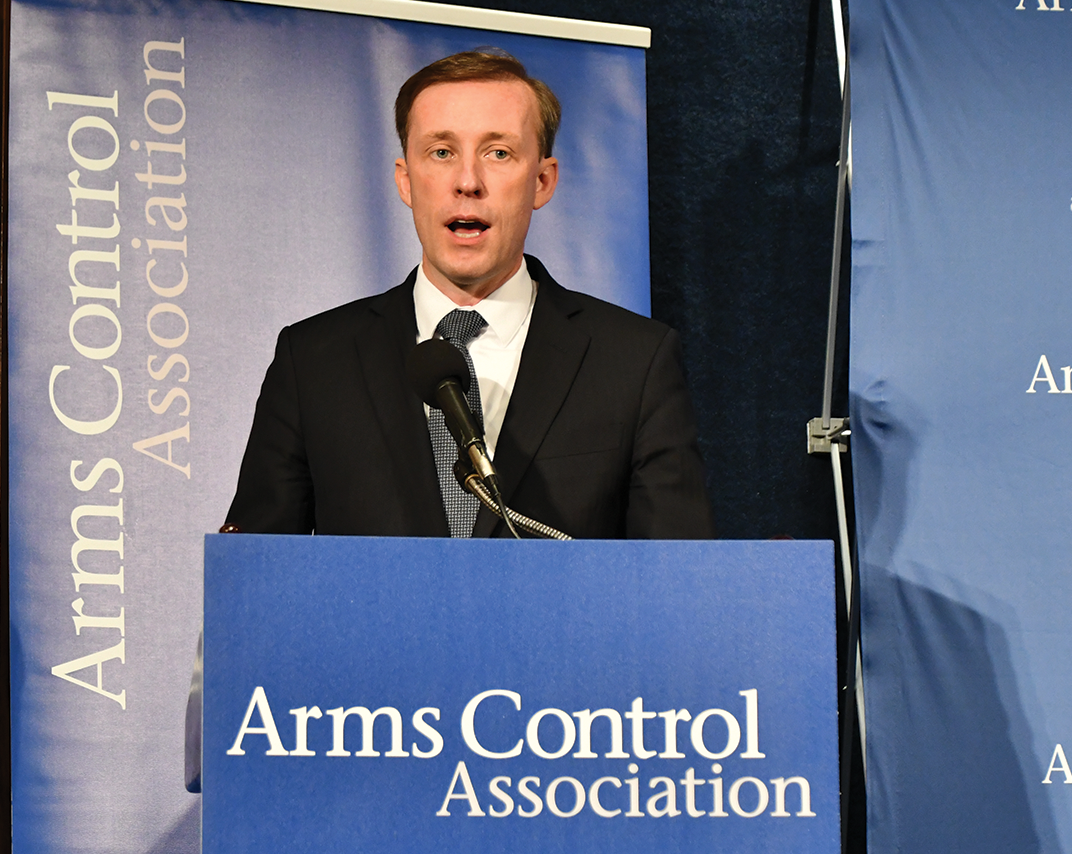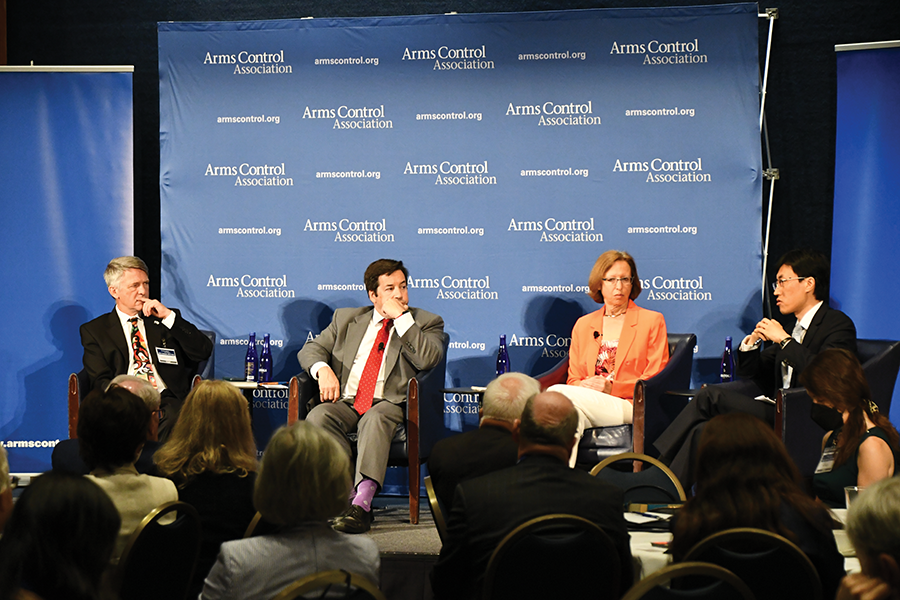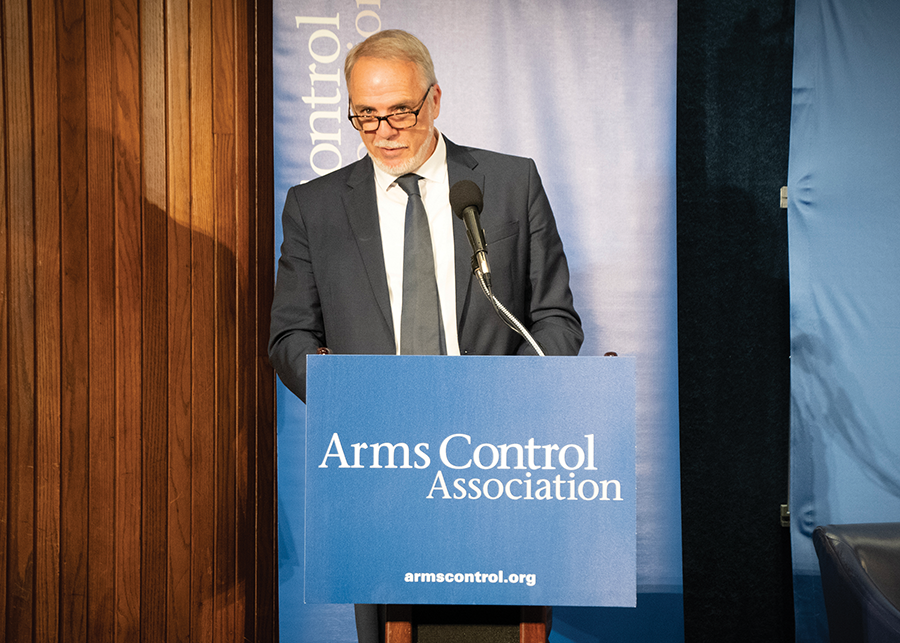"I find hope in the work of long-established groups such as the Arms Control Association...[and] I find hope in younger anti-nuclear activists and the movement around the world to formally ban the bomb."
The Arms Control Association’s 2023 Annual Meeting: Excerpts of Remarks by Keynote Speakers, as Prepared for Delivery
July/August 2023
U.S. National Security Advisor Jake Sullivan
60 years ago next month, in grainy, black and white video, President Kennedy addressed the nation.…
“My fellow citizens,” he said, “I speak to you tonight in a spirit of hope.... Negotiations were concluded in Moscow on a treaty to ban all nuclear tests.”
After years of nonstop negotiations, or stop-and-start negotiations to be more precise, years of dialogue, years of commitment and courage, establishing the Nuclear Test Ban Treaty was a huge moment. Not only for our own national security, but for the security and stability of the world.
And as this group knows well, it was one of the first steps that would help slowly usher in an era of responsible arms control and nuclear deterrence measures. An era where nations could compartmentalize the issues of strategic stability, even if they couldn’t cooperate on much anything else. An era where adversaries could disagree and debate across basically every domain, but could always find ways to work together to limit nuclear risks. An era where world leaders chose transparency even during times of tension—especially during times of tension—because what was at stake was too important, too vital to our shared future.
That is the foundation of nuclear stability and security that we’ve depended on for decades.…
But over the last few years, that foundation has begun to erode. And today, we now stand at what our President would call an “inflection point” in our nuclear stability and security.…
Taken together, the cracks in our post-Cold War nuclear foundation are substantial, and they are deep. And today, we’re entering a new era, one that demands new strategies and solutions to achieve the goals we’ve always had: Prevent an arms race, reduce the risk of misperception and escalation, and most importantly, ensure the safety and security of our people and people around the world from nuclear threats.…
That’s the core of our approach to strategic stability—one that can be boiled down to two main lines of effort. First, update our deterrence capabilities and plans, and second, advance new arms control and risk reduction measures.…
Responsibly enhancing our deterrent capabilities allows us to negotiate arms control from a position of strength and confidence, and new arms control helps limit and shape our adversaries’ decisions on nuclear capabilities.…
First, we’re modernizing our nuclear program here at home. In practice, that means replacing each leg of our nuclear triad: land-based ICBMs, ballistic missile submarines, and nuclear-capable bombers. It means updating our nuclear command, control, and communications architecture by replacing aging capabilities with next-generation systems. And it means investing in our nuclear complex and defense industry to help ensure that we have a responsive nuclear enterprise and a resilient base for long-term competition.
And I want to be clear here: the United States does not need to increase our nuclear forces to outnumber the combined total of our competitors in order to successfully deter them. We’ve been there. We’ve learned that lesson.
Nor does the United States need to deploy ever-more dangerous nuclear weapons to maintain deterrence. Rather, effective deterrence means that we have a “better” approach, not a “more” approach. It means ensuring that we have the capacity and capabilities necessary to deter and, if necessary, defeat major aggression against our country, our allies, and our partners.…
But we can’t go at it alone, which leads me to the second prong of our deterrence strategy: investing in and strengthening our alliances abroad. That has been President Biden’s overriding priority—indeed in many ways, his strategic North Star—since his very first day as President of the United States.
And as we’ve worked to further deepen our alliances, we’ve always remembered that one of our greatest nonproliferation accomplishments of the nuclear age has been U.S. extended deterrence, which has reassured so many of our partners that they do not need to develop nuclear weapons of their own.
Together with our NATO allies, we’ve been laser-focused on modernizing the alliance’s nuclear capabilities, from ensuring broad participation in the alliance’s nuclear deterrent mission to certifying our F-35 aircraft to be able to deliver modern nuclear gravity bombs. All of these new steps, from revitalizing our nuclear program here at home to reinvigorating our alliances abroad and all of the elements that fall into those two categories, are necessary in their own right. But taken together, they’ll help achieve the same strategic stability goals we’ve always had.
They’ll show our adversaries and competitors that, in an arms race with the United States—that any arms race with the United States—is counterproductive at best and destructive at worst. And they’ll help the United States negotiate arms control agreements from that position of strength and confidence that I described.…
And under the President’s leadership, we’re advancing three new approaches to strengthen arms control and decrease nuclear risks in this changing nuclear age. First, we have stated our willingness to engage in bilateral arms control discussions with Russia and with China without preconditions.
 And before I jump into this, let me just step back and say that “without preconditions” does not mean “without accountability.” We’ll still hold nuclear powers accountable for reckless behavior, and we’ll still hold our adversaries and competitors responsible for upholding nuclear agreements. For example, the United States will continue to notify Russia in advance of ballistic missile launches and major strategic exercises, in line with preexisting nuclear agreements.
And before I jump into this, let me just step back and say that “without preconditions” does not mean “without accountability.” We’ll still hold nuclear powers accountable for reckless behavior, and we’ll still hold our adversaries and competitors responsible for upholding nuclear agreements. For example, the United States will continue to notify Russia in advance of ballistic missile launches and major strategic exercises, in line with preexisting nuclear agreements.
But yesterday, we adopted lawful, proportionate, and reversible countermeasures in response to Russia’s violations of New START, including suspending our day-to-day notifications to Russia that are required under the treaty. These steps will help guarantee that Russia does not receive benefits from a treaty they refuse to abide by and that the principle of reciprocity—a key tenet of strategic arms control—is upheld.
It will also demonstrate to Russia the benefits of returning to full compliance, including once again receiving detailed information regarding our nuclear forces, a conversation we continue to press for directly with Russian officials.
But, while claiming to suspend New START, Russia has also publicly committed to adhere to the treaty’s central limits, indicating a potential willingness to continue limiting strategic nuclear forces through 2026.
We agree. It is in neither of our countries’ interests to embark on an open-ended competition in strategic nuclear forces, and we’re prepared to stick to the central limits as long as Russia does.
And rather than waiting to resolve all of our bilateral differences, the United States is ready to engage Russia now to manage nuclear risks and develop a post-2026 arms control framework. We are prepared to enter into those discussions.
Now, the type of limits the United States can agree to after the treaty expires will of course be impacted by the size and scale of China’s nuclear buildup. That’s why we’re also ready to engage China without preconditions, helping ensure that competition is managed and that competition does not veer into conflict.
Next, the United States is willing to engage in new multilateral arms control efforts, including through the five permanent members of the U.N. Security Council, the P5: the United States, Russia, China, the United Kingdom and France. We’re under no illusion that reaching risk reduction and arms control measures in that setting will be easy. But we do believe it is possible.
Ambassador Alexander Kmentt
Director of the Disarmament, Arms Control and
Non-Proliferation Department, Austrian Federal Ministry for European and International Affairs
I wanted to try to contribute to the discussion in D.C. the perspective that I believe is widely shared among the non-nuclear majority of states. I believe the needed U.S. leadership on these issues requires a better understanding of and more engagement with these perspectives.
It is a perspective that goes beyond the 92 states that have signed or ratified the Treaty on the Prohibition of Nuclear Weapons (TPNW) or the 125 states that vote for it in the UN General Assembly. At the last [nuclear Nonproliferation Treaty] NPT review conference, 150 non-nuclear-weapon states again joined a statement about the humanitarian consequences of nuclear weapons.
It is a perspective of concern that the nuclear sword of Damocles still hangs above humanity with existential nuclear risks imposed on the entire international community [and that there is an] apparent inability of nuclear-armed states to extract themselves from a security paradigm that relies on the threat of mass destruction. It is also a perspective informed by significant new scientific research and facts about the grave, complex, and global humanitarian consequences of nuclear weapons, as well as the risks associated with these weapons and the practice of nuclear deterrence. This perspective is, thus, based on profound arguments and legitimate security concerns of non-nuclear-weapon states.
Nevertheless, it is mostly disregarded in the international security and nuclear weapons discourse that is dominated by the geopolitical interests and strategic relations of the major military powers. There is a whole world out there in the nuclear debate beyond the United States, Russia, and China.
The result has been an increasing disenfranchisement and a deep sense of injustice about the nuclear treaty regime and the nuclear status quo as a whole.
The TPNW should be understood as the majority of non-nuclear-weapon states wanting to democratize this discourse and claim agency on one of the gravest existential and civilizational risks that humanity faces.
Nuclear risks were on the rise long before the Russian invasion in Ukraine and the subsequent implicit and unmistakable nuclear threats issued by President [Vladimir] Putin and others.
These are heightened geopolitical competition, arms race dynamics, the decline of arms control, and the nuclear disarmament and nonproliferation regime. Nuclear risks are increasing, including through new technologies and corresponding vulnerabilities among others.
But this already disconcerting state of affairs is dramatically compounded by Russia's irresponsible nuclear rhetoric and the potential for nuclear escalation of the war in Ukraine.…
We are now at a fork in the road on the nuclear weapons issue. One conclusion that states may draw from this crisis is an even stronger emphasis on nuclear deterrence. We heard this also this morning. This likely takes us down the path of more competition, new nuclear arms races, more proliferation pressure, and further increasing global nuclear risks.
The non-nuclear-weapon majority hopes that this moment of heightened nuclear dangers finally leads to an alternative conclusion, namely, that the crisis has brought into sharp focus the fragility of nuclear deterrence, that nuclear arms races much be avoided, that the situation in Ukraine is so much more dangerous because of nuclear weapons; that this increases concerns about the sustainability of the nuclear status quo; and that a paradigm shift on nuclear weapons is needed.
A paradigm shift would mean two things: a critical reassessment of the veracity of the arguments that underpin nuclear deterrence and a weighing of these arguments against the empirical evidence on the humanitarian consequences and risks of nuclear weapons. This is what non-nuclear-weapon states are demanding and what is now enshrined in the TPNW.…
Nuclear deterrence is seen as the ultimate security guarantee. It is believed to have prevented nuclear conflict in the past decades and to do so in the current circumstances and in the foreseeable future. This belief is very deeply entrenched. Nothing must challenge it.
The problem in this is that, in reality, we lack the hard empirical evidence. Nuclear deterrence is a theory. It assumes and projects actions, intentions, consequences, and expected outcomes.
We can’t prove that nuclear deterrence has worked in the past or will work in the future, just as much as it cannot be proven that it has not prevented conflict in the past or will not do so in the future. Even a clear deterrence “success” in a particular crisis would not prove that, in the next, different situation, it would work again.
Like any human belief system, nuclear deterrence depends on assumptions and carries within it the risk of overconfidence and a potential confirmation bias.…
By contrast, here we have a lot of empirical evidence and a growing body of research on the broad range of humanitarian consequences of nuclear weapons and of the risks of accidents, miscalculations, and human and technical error.
All the research and new modeling that I have seen concludes that the consequences of a nuclear conflict are graver and more complex and likely global.…
Would it not be prudent to base policy decisions regarding nuclear weapons primarily on these empirical facts rather than on the assumptions that underpin deterrence and that are fraught with uncertainties?...
The whole world carries the risks of nuclear deterrence failing.… This raises profound legal, ethical, legitimacy, and international and intergenerational justice questions.…
At this moment of very high nuclear risks and in the face of Russia’s aggression and nuclear rhetoric, the international community should really strive to be united in reenforcing the taboo against use or threat of use and nuclear blackmail; taking all actions to reduce nuclear risks; and recommitting to the nuclear disarmament and nonproliferation regime and to the goal of a world without nuclear weapons.…
I appreciate the comments by Jake Sullivan from today of wanting to keep engaging with Russia and China on arms control without preconditions, but the future of arms control is similarly conditioned by nuclear deterrence. Here, I just want to point out that the failure of the United States and Russia and other NPT nuclear-armed states to engage in negotiations to end the arms race and achieve disarmament would be a violation of the NPT and a threat to the NPT.
This overarching conditionality was again obvious at the recent NPT review conference. Yes, Russia blocked the outcome document, but what was on the table for adoption was deeply disappointing for non-nuclear-weapon states. Nuclear-weapon states are not ready to conceptualize nuclear disarmament in any other way than as an aspirational goal to be achieved maybe in a distant future security environment when nuclear weapons may not be needed. There are no credible plans how to actually achieve this goal.…
[H]ow long can we continue to assume that nuclear deterrence will hold and nuclear weapons will not be used? We see Russian roulette being played at the moment. How can we be confident of this in the future, in tensions with China, with [North Korea], or between India and Pakistan, or in a potential Middle East proliferation context?...
The TPNW codifies the delegitimization of nuclear weapons because of their unacceptable humanitarian impact and risks.…
The TPNW is not a silver bullet answer for future security challenges, but nuclear deterrence most definitely is no silver bullet either and certainly not a sustainable one. In these extremely dangerous times, we need leadership, and we need cooperation. The TPNW is a constructive and serious investment into international law and the common security of all.
Excerpts of addresses by the two keynote speakers at the 2023 Arms Control Association annual meeting, U.S. National Security Advisor Jake Sullivan and Austrian diplomat Alexander Kmentt, a key architect of the 2017 Treaty on the Prohibition of Nuclear Weapons, have been edited for length and clarity. For the video recordings of the keynote speeches and panel discussions, visit:
For the text of Sullivan’s speech, visit:
For the text of Kmentt’s speech, visit:
|
